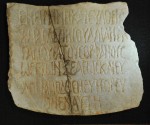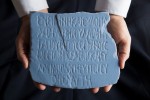 An Egyptian epitaph from the 3rd century A.D. has been recently translated revealing a unique combination of descriptors. The epitaph is part of a collection of Greek and Coptic artifacts in the University of Utah’s J. Willard Marriott Library. The collection was donated to the library in 1989 after the death of the collector, Doctor Aziz Suryal Atiya, an eminent Coptic historian who taught history at the University of Utah and founded the university’s Middle East Center in 1959. The Aziz S. Atiya Middle East Library, an internationally renown center for research in Middle Eastern history with the fifth largest collection in the United States, has hundreds of thousands of books, manuscripts and rare artifacts.
An Egyptian epitaph from the 3rd century A.D. has been recently translated revealing a unique combination of descriptors. The epitaph is part of a collection of Greek and Coptic artifacts in the University of Utah’s J. Willard Marriott Library. The collection was donated to the library in 1989 after the death of the collector, Doctor Aziz Suryal Atiya, an eminent Coptic historian who taught history at the University of Utah and founded the university’s Middle East Center in 1959. The Aziz S. Atiya Middle East Library, an internationally renown center for research in Middle Eastern history with the fifth largest collection in the United States, has hundreds of thousands of books, manuscripts and rare artifacts.
The inventory note for the epitaph described it as a “Coptic inscription, dating from the dawn of the use of the Greek alphabet, not earlier than the second century, but not later than the third.” The small limestone slab, seemingly unremarkable, was left untranslated for more than 25 years until it caught the eye of Brigham Young University adjunct professor of ancient scripture Lincoln H. Blumell. He realized the description was wrong, that the inscription was in ancient Greek, not in Coptic using Greek letters.
The inscription reads:
In peace and blessing Ama Helene, a Jew, who loves the orphans, [died]. For about 60 years her path was one of mercy and blessing; on it she prospered.
It’s the combination of the honorific “Ama,” a title used to describe Christian women, mainly nuns, in late ancient Egypt, with her Jewish identification that is unprecedented.
“I’ve looked at hundreds of ancient Jewish epitaphs,” Blumell said, “and there is nothing quite like this. This is a beautiful remembrance and tribute to this woman.” […]
Considering the unique use of dual-faith identifiers and the timeframe alone, the epitaph is unique with no known parallels.
Additionally, Blumell notes there is even more to the inscription. Scholars have noted from other inscriptions that Egyptian women during this timeframe had a life expectancy of 25 years. To live 60 years, as noted in the inscription, was incredible. Also, during a time when any sort of social programs were unavailable to orphans, taking care of them was seen as a very noble pursuit. Serving the widows and orphans is a common call to action in the New Testament.
 I had doubts about that life expectancy statistic. I thought it might be a misinterpretation of average life expectancy, an average which is extremely low in places and times when infant and child mortality was high. The average age of death skews far younger because so many children died young. Once people managed to survive to adulthood their real life expectancy was significantly higher. I was wrong. According to ancient census data from Egypt in the first three centuries A.D., fully 61% of women were dead by the age of 30. Men had it only slightly better with 59% dying before they hit their 30s. Helene was one of fewer than 6% of Egyptian women from this period who lived to see 60.
I had doubts about that life expectancy statistic. I thought it might be a misinterpretation of average life expectancy, an average which is extremely low in places and times when infant and child mortality was high. The average age of death skews far younger because so many children died young. Once people managed to survive to adulthood their real life expectancy was significantly higher. I was wrong. According to ancient census data from Egypt in the first three centuries A.D., fully 61% of women were dead by the age of 30. Men had it only slightly better with 59% dying before they hit their 30s. Helene was one of fewer than 6% of Egyptian women from this period who lived to see 60.
Blumell has published his findings in the forthcoming issue of the Journal for the Study of Judaism.
I wonder what exactly took them 26 years ? – Ok, don’t blame me for my own, by the way rather lousy Greek, but could “ἰουδαια” be the past tense of ἰουδαίζω (=to side with), or maybe a family name (like e.g. “Papachristos”) ?
—————————–
ἐν εἰρήνα καί εὐλογία Ἁμᾶ Ἑλένη ἰουδαια [past tense of ἰουδαίζω?: “to side with”] ἣ ἀ̣γαποῦσα [past tense of ἀγαπάζω ?: “treat with affection”] τοὺς ὀρφανούς.
In piece and good wishes to Ama Helene, who with loving care sided with the orphans.
—————————–
Where does it read that she “died at around 60” (“ἑξήκοντα”) ?
In Piece and Good Wishes,
Tex
Jewish Epitaph: Formula: The Jewish epitaph through time and history is composed of certain standard components. Frequently, the epitaph opens with the abbreviation פ נ short for “Here lies” poh nitman (m.)/ poh nitmenah (f.) or “Here is buried” poh nikbar (m.) or poh nikberah (f.), typically. Next follows brief epithets of the deceased, such as “modest” or “important” for a woman, and “perfect and upright” for a man. The deceased’s given name, frequently preceded by a title follows. Most often married women are designated as ‘marat’ “Mrs.” while men are acknowledged as ‘mar’ “Mr.” Yet variations in this title are prevalent depending on the age and especially the man’s position as a rabbi and teacher in the community.
what means Jewish epitaph?
A conjecture: a principal cause of death in women in their 20s was childbirth. Once through that age, or perhaps never having given birth, they must have had a much better chance of reaching 60. Perhaps she especially cared for orphans because she had never had children of her own?
I have always shared Livius’ concerns about the impact of child mortality on average life expectancy.
When these figures are given, I always want to ask or the average life expectancy at the time for those reaching 21.
Ok, it might be a bit unfair to ask this on Shabbat, fair enough, but not a single attempt to conjugate “ἰουδαίζω” ?
When it comes to “averages”, it also might be a bit misleading to look at the statistical mean of rather skew distributions. Obviously, child mortality was a factor. However, people like Ramses II died at -what was it: 92, 94 or maybe 96 ?- and they must have appeared “truly immortal”. Therefore, the statistical median might give a better picture here (indeed just an idea, and we cannot ask them directly).
————-
PS: BTW, I’ve just been informed that seemingly “all Jewish denominations encourage the following activities on Shabbat: Reading, studying, and discussing …”
Ἰουδαια can only mean “Jewish” here; it’s not a verb form. ἀγαποῦσα is morphologically a post-classical Greek present participle of ἀγαπάω, but refers to her continued activity while alive, and so can be translated as a past tense. The number 60 is expressed merely by the letter Ξ, and I suppose it’s only an estimate because nobody knew the exact date of Helena’s birth. For a similar thought, cf. Anonymous, Historia imperatorum liber ii.2429-31 Τῷ αὐτῷ ἔτει ἀπέθανε καὶ ἡ βασίλισσα Πλακίλλα, ἡ γυνὴ Θεοδοσίου, εὐσεβεστάτη οὖσα καὶ ἀγαποῦσα τοὺς πτωχοὺς καὶ ξένους (which I imagine Blumell cites in his article, which I haven’t seen yet).
Could somebody explain the life expectancy tables to me? Are they saying that in a group of 350 males the breakdown by age cohort would look like that (e.g. 50 living kids aged 0-4 and 1 old man aged 80-84 still alive). But if that’s the case the female numbers don’t make any sense at all. They essentially indicate very few females died before age 25 because the cohorts are almost equally large?
Or is it actually a mortality table saying that out of 350 males and 337 females this many died in each age cohort between censuses? Which makes the female table less weird but still weird.
Or is it something completely else?
I just don’t understand how somebody can be so oblivious they think no detailed explanation is necessary for such tables. People can try and deduce what it all means, but will face the uncertainty they drew the wrong conclusion because the numbers look so odd.
I can think of three possible explanations for the unusual use of “Ama”. One, if the late Helene was dedicated to the kind of charitable works that were commonly done by religious organisations then the writer of the epitaph might have thought that it was an accurate description of how she lived even if she didn’t actually belong to any religious order. Two, she might have been born into a Jewish family then converted to Christianity and became a nun. In this case “Ama” is used in its normal sense and the description of her as “a Jew” refers to her origins. Three, her involvement in charitable works might have meant that she was often seen working with nuns who did similar things, so she might have been perceived as belonging to that group even if she hadn’t formally joined their order.